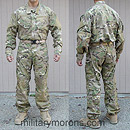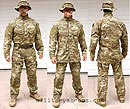CRYE PRECISION PAGE 1 PAGE
2 PAGE 3 PAGE 4 PAGE
5 PAGE 6 PAGE 7 PAGE
8
TO VIEW FULL SIZE IMAGES: USERNAME and PASSWORD are both "mm"
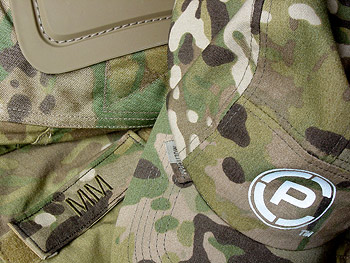
|
The MultiCam pattern is a result of extensive development
and testing over the past couple of years, by both Crye and the Army.
It is designed to work in multiple environments (hence its name) –
which include desert, woodland and urban. Although it came out on
top in Army tests, the Army has decided to go with new
ACU pattern which is basically a variation of the MARPAT pattern
used by the USMC, with changes in colour. Why they chose grey as the
overall shade, I don’t know. MultiCam is comprised of six colours, (note that I'm using names that I'm most familiar with to describe the colours and that may not be entirely accurate)- a dark chocolate brown, a medium/flat earth brown, MJK khaki/green, medium green, desert pink, and a light grey (the base fabric natural colour). What makes it difficult to describe (and see) is that some of these colours are gradiated and fade into each other in some places. Another feature of MultiCam is that is does not consist of a uniformly tight pattern that repeats itself freqently. The medium shades of colour alternate in a larger pattern, so that an area will change from a predominantly green hue to a brownish one a yard down. The small blotches of grey and dark brown will sometimes cluster in one area, then be absent in another. This combination of tight pattern and larger, 'seasonal change' enables MultiCam to work both close up and from a distance away. The large changes of overall tone break up one the silhouette of the larger form while the smaller patterns blend it with the immediate environment. Crye coined the term 'macroflage' for the way the distribution of large areas of colour works. Photo (1) on the left shows 4 different swatches cut from different areas of fabric. The top left swatch is predominantly green while the bottom left one is brown. The ones on the right incorporate the smaller blotches of colour. Photos (2) and (3) show Multicam in arid (L) and woodland (R) environments. Photo (4) shows me in the high desert. |
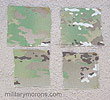 (1) 4 swatches cut from different areas of the fabric - swatch size 5"x5" |
 (2) MultiCam in an arid environment |
 (3) MultiCam with woodland camo |
 (4) High desert |
Crye Precision Field Shirt and Field Pants - Gen I (Discontinued - for reference only)
|
Crye's Field Shirt and Field Pants are their BDU-style articles of clothing. Let me start by saying a big 'Thank You' to Crye for the opportunity to preview these before they come out, and to give the reader a good idea of what to expect. The projected release is late-November for the more common sizes and pre-ordering is up on their website. I'll update this if I hear anything different. But they will be available from Crye Precision. The Field Shirt and Pants form part of Crye's 'B-line' apparel. The 'A-line' apparel includes the Combat Shirt and Pants, which are much more specialized articles of clothing, mainly meant to be worn with body armour (BDU's on steroids, is all I can come up with at this moment). The terms 'A-line' and 'B-line' are internal designations, used just because the 'A-lines' came first. The 'B-line' Field Shirt and Pants can best be described as 'Enhanced BDUs' for more general use, whereas the 'A-line' is more specialized and more direct-action oriented. Upon examining the Crye BDUs, it's obvious that a lot of thought has gone into their design, and choice of materials and construction. The Field Shirt and Pants are the result of extensive research and collaboration with operators in the Spec Ops community. Read on... |
|
The Field Shirt I was sent was Multicam 6-6.6 oz 50/50 USMC NYCO twill material. It has a 5-button front closure, and no lower front cargo pockets. Here are the main features of this garment:
The Field shirt is extremely comfortable in the lightweight twill. The mandarin collar is comfortable with no chafing. Workmanship is some of the best I've seen - much better than issue BDUs. All pocket flaps corners are angled off, a feature that I like, and all stress points are bartacked. |
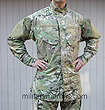 Overall front view - no lower pockets |
 Double shoulder pockets on each side with velcro flap closure |
 Front breast pockets |
 Side entry pocket under front breast pocket |
 Another view of the front/side breast pocket |
 Closeup of the flap design and closures |
 Tag |
 Elbow reinforcement and pad pocket |
|
The Field Pants are made of a slightly heavier 7 oz 50/50 NYCO twill for harder wear. Here's a rundown of the features:
Like the Field Shirt, the attention to detail in the design of the Field Pants is apparent. Even the internal pockets have small grommeted drain holes. The shaped elbow and knee pads very lightweight, are lined with fabric, and have a smooth, hard, outer shell. Any flat foam can be cut and used, but I'd go with the optional Crye shaped pads. Note: that's a SOTECH slim rigger belt I'm wearing with the pants, in case anyone was going to ask. |
 Front pocket overview |
 Pants rear overview |
 Reinforced knees and calf pockets |
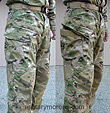 Main side cargo pockets |
 Shaped knee pad |
 Closeup of calf pockets with lightstick holders |
 Crye shaped elbow and knee pads |
| The Khaki Field pants are a more 'civilianized' colour - they're still hard-wearing combat trousers but wearing them around town won't attract any attention. The khaki material is a heavier-weight twill than the MultiCam field pants, and instead of the 500D cordura on the knees, the same material as the pant is used. Note that if you use the knee pad inserts in the khaki pants, the fabric on the knees is not as wear and tear resistant as the cordura on the MultiCam pants.
|
 |
 Closer view |
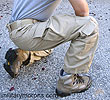 |
|
On the range. I headed out to the range yesterday for a 1-day refresher carbine/pistol class. I wore the Crye Field uniform the entire time, and even though it was about 85°F out there, the lighter weight of the shirt made it comfortable. I found that the 500D knee reinforcements provided enough protection without the shaped knee pads for occasional kneeling. I didn't get to utilize all the features of the field uniform or abuse it much this time, but I'll add comments when I do. Used the knee pads more and I like them a lot. They're light enough so that they don't inhibit my movement, and provide just the right amount of padding. The lack of elastic straps behind the knees really adds to the comfort of the pads. Even though they do get warm, air is able to circulate between the knee and the pad when standing and moving, as there aren't straps holding the pads to your knees constantly. This gives the knees a chance to dry out. |
Crye Precision R6 Field Shirt and Field Pants (Discontinued - for reference only)
|
10/17/06 - Crye Precision R6 Field Shirt and Field Pants, overview. Note that this model has been discontinued and is no longer in production. Crye has just introduced their R6 Field Shirt and Field Pants in Ripstop MultiCam and Black fabric (Sand to be offered in the near future). Check their website, Crye Precision for availability. While it's the '2nd Generation' or version that has been offered to the commercial market, it's actually the sixth revision of the Field Uniform. The others were made for non-commercial customers. Hence the designation 'R6' (Revision 6). First of all, please read the writeup on the Gen 1 Field Shirt and Pants as a 'refresher' if you haven't already. Unless mentioned in this writeup, the R6 shares the same features as the Gen 1 with a few changes. The most noticeable update for the R6's is the new
Ripstop material offered. It's 50/50 NYCO and feels identical to 50/50
NYCO DCUs that I have, which means that it feels slightly stiffer
(when new), but lighter and less 'lofty' than the 6-6.6 and 7 oz 50/50
USMC NYCO twill material used in the Gen 1 Field Uniform. The Gen
1 field uniform I have has become very soft and comfy through multiple
washings and wearing. There's also a perceived feeling that the ripstop
material feels cooler because it's less 'lofted' than the twill and
doesn't get as 'fuzzy' with a lot of use. Whether it breathes better,
I don't know. But the ripstop does give an impression of increased
durability and abrasion resistance. The same weight ripstop material
is used for both the Field Shirt and Pants. The Gen 1 Pants were made
of the slightly heavier weight twill than the shirt.
|
|
The R6 Field Shirt shares the same basic features as the Gen 1 (outlined above) - these are the changes:
|
 Overall front view - collar down |
 Rear view |
 Collar down |
 Collar up |
 Sleeve pocket |
 R6 and Gen 1 cuffs open |
 Cuffs closed |
|
The R6 Field Pants are made of the same 50/50 NYCO Ripstop fabric as the Field Shirt which makes them lighter than the heavier twill of the Gen 1 pants. All features are the same as the Gen 1 unless otherwise mentioned:
Gen 2 Knee and Elbow pads - The Gen 2 knee and elbow pads have actually been out for a while. Instead of the foam lined, gray hardshell of the Gen 1, the Gen 2 pads are molded/shaped foam covered in nylon fabric. They're not as stiff and conform/bend better, and when used on rough ground, will impart less wear and tear to the pad pockets than the hard Gen 1's. They're also lighter. With the first runs of the Gen 1 Field Uniform, there were some reports of QC issues with stitching/workmanship - loose buttons, stitches coming undone on seams or velcro etc. The R6 uniform shows no sign of that, and all the stitching and quality looks good to go. Personally, I prefer the features and fit of the Crye Field Uniform over standard BDUs, and with the R6's in ripstop, they're even better. And they're still made in the USA with US materials.
|
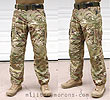 Front overview |
 Pants rear |
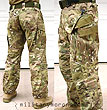 Reinforced knees and side pockets |
 Elbow pads (Gen1 on left) |
 Knee pads (Gen 1 on left) |
 Elbow and knee pad pockets |
 Dual-access chest pocket |
 Flexible velcro configuration |
 Dual layer bicep pocket |
 Patch on velcro |
 Pen and eye pro slots |
 Reinforced elbow |
 Cuff details |
The Crye Precison G3 Field Shirt is shown below in Khaki.
|
| 7/27/11 -The Crye Precision WindLiner™ is an extremely light weight and packable jacket that offers outstanding widn and weather resistant in a featherweight package. It stuffs into its single mesh-lined shoulder cargo pocket. The WindLiner actually debuted at the 2010 SHOT Show, and was there again in 2011 but hadn't really made it out until now. The WindLiner is intended as a ultra-packable zip-front shell that is designed to be donned over a uniform or other garments in case of inclement weather. It's not intended to replace a hard shell rain jacket, but be light weight enough to carry along in case some unexpected protection from the weather is needed. Like Crye's Jumpable Plate Carrier (JPC), the WindLiner follows the light weight/minimalist design philosophy, yet still offers features that a truly mimalist garment might omit. I've been using an original Arktis Stowaway Shirt for more than a decade, and while it packs down smaller than the WindLiner, it's truly devoid of any features like a hood or pockets. Here's a summary of the features on the WindLiner, size large shown here (I usually wear medium, so bear that in mind when using the pics as a size reference):
Sizing, fit etc - The WindLiner has a relaxed fit/cut; as it's meant to accommodate other garments under it like a uniform or mid-layer. I normally wear a size Medium, but I am wearing a Large in the photos. If you anticipate wearing it alone as a windbreaker or over thin baselayers, then get your normal size. If you think you'll be wearing it over thicker layers, then go one size up. Notes and Observations - The Nanosphere DWR works pretty well in light rain/drizzle. Water beads up and doesn't soak through unless it's been sitting for a while or it's rubbed in. We had some heavy rain earlier this year and I had a chance to test out all my rain gear. The WindLiner isn't waterproof or a rain jacket substitute, but I was still curious as to how it'd hold up when it rained. Light showers/drizzle is no problem. I wore it over a fleece jacket as it was cold outside. In medium rain, it held the water at bay for a while, then I'd notice some dampness on the head and shoulders, on the most exposed areas, which was to be expected. Even when it was damp, it still kept working to stop the majority of the rain penetrating into the fleece underneath. Same thing in heavier rain - it's not going to keep you completely dry, but it'll definitely keep you drier than if you didn't have it, and slow down your under-layer getting wet. Filling up a sink with water, the fabric held the water for a while, and after about 10 minutes, started wetting through. It was definitely more water-resistant than the Crye MultiCam 70D 1.9oz nylon with a ripstop pattern I'd tested before on the OTTE Super L Windshirt. The hood is close-fitting and non-restrictive. I wouldn't have minded having a brim in the rain (because I wear eyeglasses), but this hood was also designed to be worn under a helmet, and a brim would interfere. In any case, a hat will help keep the rain off my face. The Epsilon fabric is also much more wind-resistant than the 70D 1.9oz ripstop nylon; I cannot blow through it. I tested it out under a mesh motorcycle jacket, and worn over a sweatshirt on a cold morning. I usually have a leather jacket for winter and a mesh jacket for summer, but wanted to see how well the WindLiner worked. Without the WindLiner, the cold air just cuts right through the mesh jacket and the sweatshirt doesn't do much to keep me warm. With the WindLiner over the sweatshirt and under the mesh jacket, it blocked the wind completely, and also helped keep me warmer by trapping body heat under it. It made a huge difference in comfort, even though it's such a thin material. Note that it will not keep you warm by itself, but it'll make an insulating layer or your regular clothes much more efficient if there's a cold wind blowing. Another thing to note is that the Epsilon fabric is pretty quiet, when compared to other nylons. It doesn't have a high-pitched 'swish' like GoreTex fabrics. I was able to stuff the WindLiner into an EMDOM Baby Utility Shingle, which is 5.5" x 3.5"x 1.5", and also an M4 double magazine pouch, which is pretty small. Stuffed into its own pocket, it'll fit easily in pants cargo pockets, jacket pockets, emergency kit, GP pouches etc. It doesn't take up hardly any room. The WindLiner is useful is as an ultra light shell over a fleece garment or base layer, to help trap warm air in the insulative layer; and also to help shed light rain or snow and keep the insulative layer dry. Or, as a light windshirt over a t-shirt when the sun goes down. It's light and packable enough to carry along when a more bulky softshell or hardshell might not be.
|
Crye Precision Range Vest (Not in current production - for reference only)
|
Crye Precision's Range Vest is intended to be worn in conjunction with the Combat uniform shirt (A-line) when the body armour/load bearing system is not being worn, as the Combat shirt doesn't have pockets on the torso portion. It can also be used as a stand-alone vest, of course. It's not meant as a substitute for nylon load bearing equipment, but provides some utility and the ability to carry a few mags and some gear in case of an emergency. It also should work well as a 'range vest' for shooters. It'll be available in khaki for those who want a more 'civvie' look. Thanks again to the guys at Crye for the opportunity to preview this product. My first impression of the Range Vest was that it was much more sturdily constructed than I had envisioned. I expected a 5.11/Royal Robbins-type vest; lightly constructed and loose. The Range Vest has a much more solid feel as it's made of heavier material, with an array of built-in features that add to its structural integrity. The Range Vest shown here is part of a prototype run, so some minor tweaks might be made for the final production version. It's constructed of the same material as the Pants - 50/50 NYCO heavy weight twill. Here are the main features of this garment:
The vest fits great - I like being able to adjust it to just the right snugness. It really makes a difference when the pockets are loaded up. Although its original intention was to compliment the Combat shirt, I think it'll be just as popular as a stand-alone item, for those who want something more ruggedly built than the others currently on the market. |
ATTENTION! PLEASE DO NOT LINK DIRECTLY TO MY IMAGES
-
IT RESULTS IN MY BANDWIDTH ALLOCATIONS BEING EXCEEDED,
AND MY PAGES GO DOWN. THANKS!
/ . PLEASE
OBSERVE AND RESPECT OUR COPYRIGHT! . /
©opyright by MilitaryMorons.com. All Rights Reserved. Reproduction, Duplication,
Distribution Strictly Prohibited.
Unless mentioned otherwise, content and images are the
property of militarymorons.com and are not in the public domain.
They are not to be used without
permission. Please Contact
me for permission to use any images or content herein.
